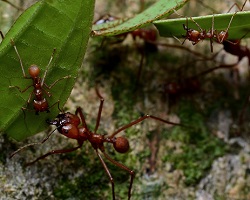show/hide words to know
Larva: the second, "worm-like" stage in the life cycle of insects that undergo complete metamorphosis (like caterpillars).
Larvae: plural of 'larva.'
Pupa: resting stage during which tissues are reorganized from larval form to adult form. The pupa is the third body form in the life cycle of insects that undergo complete metamorphosis (like caterpillars).
Pupae: plural of 'pupa'.
Leafcutter Ant Colonies
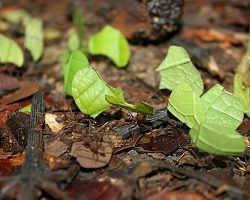
At first a leafcutter trail might look like a long line of leaves moving around. Image by Eli Duke.
Deep in the rainforest, you see a very long trail of ants moving along the forest floor. Many of the small ants are each carrying a large piece of a leaf. These leafcutter ants are collecting leaves for use in their colony.
Like any community, a leafcutter ant colony has a lot it needs to do every day. Leafcutter ants are constantly collecting food, feeding young, growing fungus, defending their colony, and caring for their queen. With so many jobs, it helps to have certain ants do certain things. These separate jobs are called castes.
Below are some examples of the castes that can be found in some tropical leafcutter ant colonies. However, different species may have different castes.
Foragers
A forager’s job is to explore the area around her nest in search of tasty, non-toxic leaves. When a scouting forager finds a good patch of leaves, she returns to the colony. Then, she brings other foragers to the leaves. She does this by making trails of chemicals that other foragers can smell and follow.
The group of foragers will then work together to cut the leaves into small pieces and carry them back to the nest.
Guards
Watching foragers move leaves around, you may notice a few tiny ants riding on some of the bits of leaves. Are these just freeloaders, getting a relaxing tour of the forest? Not at all. Leafcutter ants have lots of enemies in the jungle that want to eat or harm them. One of their largest threats comes from a tiny parasitic fly. The flies are much too small to eat the leafcutter ants, but they like to lay eggs on the heads of ants that are busy carrying leaves. When the eggs hatch, the larvae burrow into the ant’s head, eventually killing her. The small ‘guard’ ants ride on the leaf as it is carried back to the nest to protect the forager from fly attacks.
Gardeners/Nurses
In the colony, ants don't actually eat the leaves. Instead, the leaves are used to grow a fungus that can be eaten. Certain young ants called gardeners clean and take care of whole gardens of fungus.

The ants that keep the fungus gardens healthy also feed and care for the brood. Image by Rebecca Clark.
The gardeners also work double duty as nurses. They care for the eggs, larvae, and pupae of the colony, collectively called brood. Leafcutter ant brood is found on and within tunnels of the fungal garden.
Excavators
Have you ever wondered what an ant nest looks like? Ant nests are made of many large, round chambers connected by small tunnels. Leafcutter ants use different chamber types for specific tasks. These are like the different rooms in your house that are used for specific activities. The most important and numerous chambers are for the fungus gardens. The brood develops into adult ants here. This is also where the queen lives.
Leafcutter ants have garbage chambers, where dead workers, old food, and other trash is taken. All of these chambers are built by excavator ants. They are the architects and construction workers of the colony. They expand the nest as the colony grows. Large colonies can have hundreds of chambers that reach way down into the ground. Each chamber is dug out one mouthful at a time by tireless excavators.
Trash Handlers
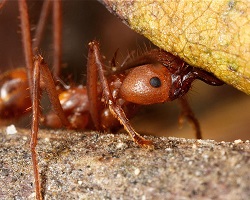
A leafcutter's large mandibles let them collect leaves, but they also use them to remove trash from the colony and to dig tunnels. Image by Yrichon.
Would you want to live in a garbage dump? Probably not. Neither do leafcutter ants, but a leafcutter colony produces a lot of garbage. Things like dead ants, bad mold, and gross leaves build up in the colony and must be removed to prevent the spread of disease.
Ants can get sick just like we can. They live very close together, so a disease can spread through a colony very quickly. Leafcutter excavators build large chambers deep below the rest of the nest. Those chambers are the garbage dumps of the colony. However, not every ant visits the garbage chambers.
There are special trash handling workers that transport dead and dirty items to the garbage chambers. This work is very dangerous because the trash handling ants touch lots of different bacteria and mold that could infect and kill them.
Once a worker becomes a trash handler, they avoid contact with important and sensitive fungal chambers where the fungus garden, queen, and brood live. A trash handler could accidentally infect the queen with a deadly disease, leading to the collapse of the whole colony.
Soldiers
However, some leafcutter ants have large soldiers with extra strong jaws or extra weaponry on their heads. Soldiers sacrifice their lives to defend their queen and colony from any threat.
Queen
The queen is the most important member of the leafcutter colony. She is the only one in the colony that lays eggs to make more ants.
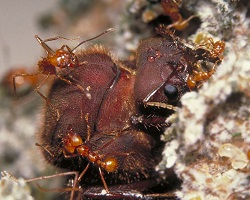
The queen is much larger than the worker ants caring for her. Image by Dan L. Perlman of EcoLibrary.org.
This means that all of the workers in an ant colony are sisters. The queen also lays some eggs that become new queens and males. These ants leave the nest to mate, and the new queens try to start their own colonies.
Even though the queen is very important to a colony, she does not give orders to any of the workers. The workers are born knowing how to take care of the colony and the queen. The queen’s only job is to lay eggs deep in the safety of her nest.
So if you were putting together an all-star leafcutter colony, which of these castes might you include? Can you think of others that might be helpful?
Images via Wikimedia Commons. Lone forager image by Scott Bauer at the USDA.
View Citation
Bibliographic details:
- Article: A Closer Look at Castes
- Author(s): Tate Holbrook, Rebecca Clark, and Brian Haney
- Publisher: Arizona State University School of Life Sciences Ask A Biologist
- Site name: ASU - Ask A Biologist
- Date published: July 28, 2014
- Date accessed: August 24, 2024
- Link: https://askabiologist.asu.edu/leafcutter-castes
APA Style
Tate Holbrook, Rebecca Clark, and Brian Haney. (2014, July 28). A Closer Look at Castes. ASU - Ask A Biologist. Retrieved August 24, 2024 from https://askabiologist.asu.edu/leafcutter-castes
Chicago Manual of Style
Tate Holbrook, Rebecca Clark, and Brian Haney. "A Closer Look at Castes". ASU - Ask A Biologist. 28 July, 2014. https://askabiologist.asu.edu/leafcutter-castes
Tate Holbrook, Rebecca Clark, and Brian Haney. "A Closer Look at Castes". ASU - Ask A Biologist. 28 Jul 2014. ASU - Ask A Biologist, Web. 24 Aug 2024. https://askabiologist.asu.edu/leafcutter-castes
MLA 2017 Style
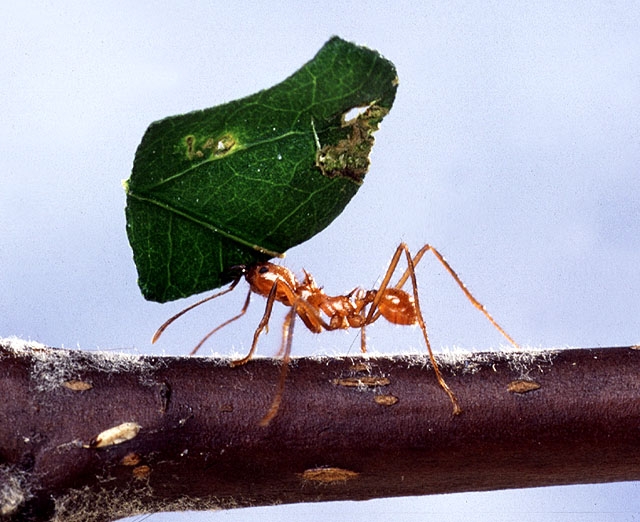
Be Part of
Ask A Biologist
By volunteering, or simply sending us feedback on the site. Scientists, teachers, writers, illustrators, and translators are all important to the program. If you are interested in helping with the website we have a Volunteers page to get the process started.








